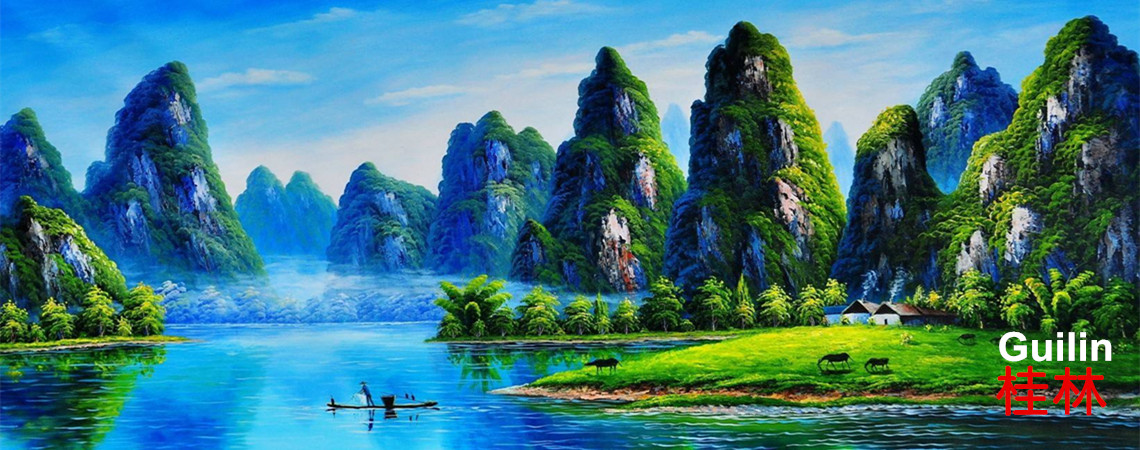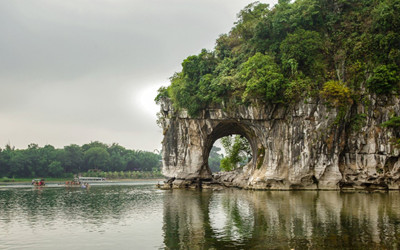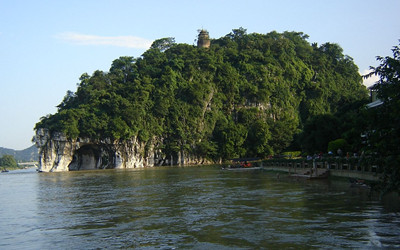
Guilin Elephant Trunk Hill
The Elephant Trunk Hill looks like a giant elephant drinking water from the river. As the landmark of Guilin, the Elephant Trunk Hill ( Xiangbishan 象鼻山) is located at the confluence of Taohua River and Li River. The Elephant Trunk Hill has been a famous tourism destination since the Tang Dynasty(618 – 907).
Legend and History
 There is an old story that circulates among the Guilin people. It is said that the hill is the embodiment of a God Elephant, who used to be the mount of the Emperor of Heaven. It was separated from the Emperor in a war and stranded in Guilin with severe wounds. A local couple saved its life and took good care of it. This animal fell in love with the life there and decided not to return to the heavenly palace. The Emperor bestowed a pagoda to help it suppress evils and protect people. Since then, it never left this place and at last became Elephant Trunk Hill. Puxian Pagoda on the top is said to be the bestowed one.
There is an old story that circulates among the Guilin people. It is said that the hill is the embodiment of a God Elephant, who used to be the mount of the Emperor of Heaven. It was separated from the Emperor in a war and stranded in Guilin with severe wounds. A local couple saved its life and took good care of it. This animal fell in love with the life there and decided not to return to the heavenly palace. The Emperor bestowed a pagoda to help it suppress evils and protect people. Since then, it never left this place and at last became Elephant Trunk Hill. Puxian Pagoda on the top is said to be the bestowed one.
This scenic area was once the frontline of the Taiping Rebellion (1851 – 1864), a mass civil war in China. The second floor of the temple serves as an exhibition gallery, reviewing this history with historical relics like battle flags, weapons, and cannonballs.
Legend and History
 There is an old story that circulates among the Guilin people. It is said that the hill is the embodiment of a God Elephant, who used to be the mount of the Emperor of Heaven. It was separated from the Emperor in a war and stranded in Guilin with severe wounds. A local couple saved its life and took good care of it. This animal fell in love with the life there and decided not to return to the heavenly palace. The Emperor bestowed a pagoda to help it suppress evils and protect people. Since then, it never left this place and at last became Elephant Trunk Hill. Puxian Pagoda on the top is said to be the bestowed one.
There is an old story that circulates among the Guilin people. It is said that the hill is the embodiment of a God Elephant, who used to be the mount of the Emperor of Heaven. It was separated from the Emperor in a war and stranded in Guilin with severe wounds. A local couple saved its life and took good care of it. This animal fell in love with the life there and decided not to return to the heavenly palace. The Emperor bestowed a pagoda to help it suppress evils and protect people. Since then, it never left this place and at last became Elephant Trunk Hill. Puxian Pagoda on the top is said to be the bestowed one.This scenic area was once the frontline of the Taiping Rebellion (1851 – 1864), a mass civil war in China. The second floor of the temple serves as an exhibition gallery, reviewing this history with historical relics like battle flags, weapons, and cannonballs.
What to see?
There are not only many spectacular natural scenes around the hill, but also some ancient constructions, such as Puxian Pagoda, Yunfeng Temple, and Sarira Dagoba.
Water Moon Cave
 Water Moon Cave is a semicircular cave between the elephant's legs and trunk. At night, the cave and its reflection together form a bright moon on the river. Although Guilin is studded with hills and caves, it is still unbelievable to see such a cave through which a river can flow. The cave is not very large, but there are more than 50 inscriptions on the wall, with the earliest one dating from the Song Dynasty (960 – 1279). There is another cave on the hillside. Because of its special location, it is taken as the eyes of Elephant Hill.
Water Moon Cave is a semicircular cave between the elephant's legs and trunk. At night, the cave and its reflection together form a bright moon on the river. Although Guilin is studded with hills and caves, it is still unbelievable to see such a cave through which a river can flow. The cave is not very large, but there are more than 50 inscriptions on the wall, with the earliest one dating from the Song Dynasty (960 – 1279). There is another cave on the hillside. Because of its special location, it is taken as the eyes of Elephant Hill.
This brick tower was built in the Ming Dynasty (1368 – 1644) to worship Samantabahdra, one of the four most reputable Bodhisattvas. There is a line-carved figure of him on the north side of the pagoda. The tower is located on the top of the hill, which not only tallies with this story, but also coincides with the fact that Samantabhadra always shows up riding an elephant.
Yunfeng Temple, on the southwest slope of the hill, is one of the famous ancient temples of Guilin. It was once the dwelling place of Monk Jianzhen, an eminent monk of the Tang Dynasty, crossing over to Japan six times to spread Buddhist doctrines and help regularize monks' behavior.
Travel Tips
Add: At Xiangbishan Park, Guilin City,China
Entrance Fee: CNY 75
Opening Hours: April to October: 6:30 – 19:00; November to March: 7:00 – 18:30
Transport: Take bus 2, 16, or 23, and get off at Xiangshan Park Station.
 Water Moon Cave is a semicircular cave between the elephant's legs and trunk. At night, the cave and its reflection together form a bright moon on the river. Although Guilin is studded with hills and caves, it is still unbelievable to see such a cave through which a river can flow. The cave is not very large, but there are more than 50 inscriptions on the wall, with the earliest one dating from the Song Dynasty (960 – 1279). There is another cave on the hillside. Because of its special location, it is taken as the eyes of Elephant Hill.
Water Moon Cave is a semicircular cave between the elephant's legs and trunk. At night, the cave and its reflection together form a bright moon on the river. Although Guilin is studded with hills and caves, it is still unbelievable to see such a cave through which a river can flow. The cave is not very large, but there are more than 50 inscriptions on the wall, with the earliest one dating from the Song Dynasty (960 – 1279). There is another cave on the hillside. Because of its special location, it is taken as the eyes of Elephant Hill.Puxian Pagoda
Yunfeng Temple
Travel Tips
Add: At Xiangbishan Park, Guilin City,China
Entrance Fee: CNY 75
Opening Hours: April to October: 6:30 – 19:00; November to March: 7:00 – 18:30
Transport: Take bus 2, 16, or 23, and get off at Xiangshan Park Station.






 Ask Questions ?
Ask Questions ?